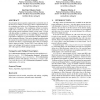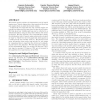54 search results - page 7 / 11 » Capturing collection size for distributed non-cooperative re... |
CIKM
2005
Springer
14 years 1 months ago
2005
Springer
Search engines process queries conjunctively to restrict the size of the answer set. Further, it is not rare to observe a mismatch between the vocabulary used in the text of Web p...
IMC
2004
ACM
14 years 27 days ago
2004
ACM
The Internet is teeming with high variability phenomena, from measured IP flow sizes to aspects of inferred router-level connectivity, but there still exists considerable debate ...
WSDM
2009
ACM
14 years 2 months ago
2009
ACM
Web search queries capture the information need of search engine users. Search engines store these queries in their logs and analyze them to guide their search results. In this wo...
ESCIENCE
2006
IEEE
14 years 1 months ago
2006
IEEE
In this paper, we describe the Vannotea system - an application designed to enable collaborating groups to discuss and annotate collections of high quality images, video, audio or...
SIGIR
2011
ACM
12 years 10 months ago
2011
ACM
Inverted indexes are the most fundamental and widely used data structures in information retrieval. For each unique word occurring in a document collection, the inverted index sto...


